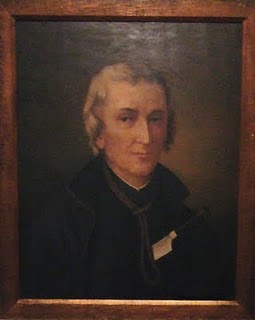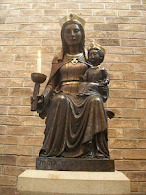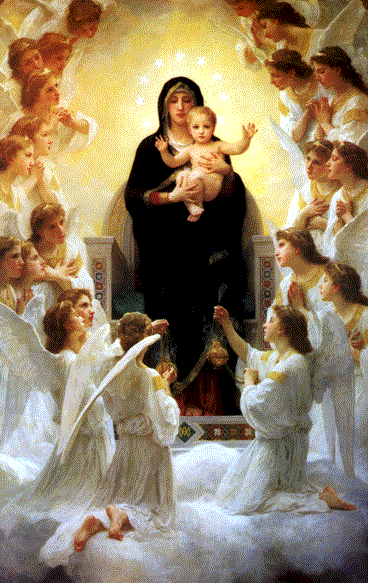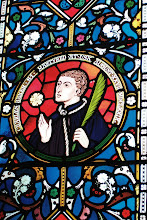
On 25th October 1970, Pope Paul VI canonised forty martyrs from England and Wales. The Forty Martyrs of England and Wales were a diverse group - men and women, priests and lay people – but, between the years of 1535 and 1679, they all shed their blood for their Catholic faith. Saint David Lewis was the last of the forty to die. Ten of the Forty Martyrs of England and Wales, including Saint David Lewis, were Jesuits. Our intention is to tell, briefly, the story of each of the Jesuits. (SEE PREVIOUS POSTS FOR PARTS 1 & 2)
5) ST NICHOLAS OWEN was born into a staunchly Catholic family around 1550. Two of his brothers, John and Walter, became Jesuit priests. Nicholas, a carpenter by trade, was consecrated by Fr Henry Garnet, Superior of the English Jesuits, as one of the first Jesuit laybrothers. Because of his size, about 5ft tall, he was nicknamed “Little John” but he was, it has been said, very strong. He put his skills and strength to invaluable use in the times of persecution in which he lived, becoming the consummate builder of priest hiding holes. (Nicholas Owen appears as a minor character in Robert Hugh Benson's 1912 novel “Come Rack! Come Rope!”, where he is erroneously named Hugh Owen.) Trusting no one, Nicholas worked alone and at night, miraculously, without ever disturbing the sleeping household. So as not to arouse suspicion, Nicholas did ordinary carpentry work by day. Of necessity, all of the priest holes had to be different. Some priest holes were merely holes under a floor, but those built by Nicholas were very sophisticated and very difficult to uncover. Pursuivants were persistent and thorough in their searches of houses for priests and they would sometimes spend weeks dismantling a property. One such search resulted in the capture of Nicholas Owen himself. After the, fortunately, unsuccessful Gunpowder Plot, oppression of Catholics increased. Nicholas and another Jesuit laybrother, Ralph Ashley, hid in one of the 11 holes at the home of Thomas Abingdon, Hindlip Hall in Worcestershire, for a week as 100 pursuivants ransacked the building in their search for Catholic priests. Eventually the two men, who had only one apple between them, staggered weak and hungry from their concealment. Nicholas was captured and incarcerated at Marshelsea. When his real identity became known, the officials were overjoyed. Cecil, the Secretary of State, wrote “It is incredible how great was the joy caused by his arrest...... knowing the great skill of Owen in constructing hiding places, and the innumerable qualities of dark holes which he had schemed for hiding priests all through England.” Nicholas was moved to the Tower where he was ruthlessly tortured. Despite his extreme pain and suffering, he disclosed nothing of his work or the whereabouts of any priests. He eventually died of the torture and the authorities, realizing that they had gone too far, tried to say that he had committed suicide on 2nd March 1606. This calumny, however, was disproved by several sources but the exact date of his death remains clouded. Some historians hold that he died on 2nd March 1606 while others claim that he lived until 12th November 1606. Whether it was March or November, Nicholas Owen died heroically for his faith. Fr John Gerard wrote of Nicholas Owen, "I verily think no man can be said to have done more good of all those who laboured in the English vineyard. He was the immediate occasion of saving the lives of many hundreds of persons, both ecclesiastical and secular”.
6) ST THOMAS GARNET, the son of recusant Richard Garnet, was born in 1575. He was still a school boy when, with the rest of his family, he spent a period in prison for recusancy. Thomas was educated at home but when the college opened at St Omer, the young man was sent there, going on, in 1595, to the English College at Valladolid. There, in 1599, Thomas was ordained. He was sent on the English Mission that same year. For six years he toiled, mainly in Warwickshire, and won many converts. He was admitted into the Society of Jesus by his uncle, Fr Henry Garnet, who was at that time, Superior of the English Jesuits. In 1605, Thomas was arrested on suspicion of being involved in the Gunpowder Plot. Cleared of any involvement in the Plot, Fr Garnet was nonetheless imprisoned for nine months before, in 1606, being banished with 46 other priests. He went to the recently established Jesuit novitiate at Louvain but returned to England in September 1607. Just six weeks later, Thomas Garnet was captured. He refused to take the new Oath of Allegiance, stating that if Catholics did take it, it was out of fear, to which he hoped he would never succumb. He was sent to Newgate Prison. He was tried at the Old Bailey, indicted on a charge of high treason, i.e., of having been ordained a priest by the authority of Rome and remaining in England. Unsurprisingly, he was found guilty and sentenced to death. On 23rd June 1608, Fr Thomas Garnet was taken to Tyburn where a great crowd, including the Earl of Exeter, had gathered to witness his execution. The Earl, a member of the Privy Council, urged the condemned priest to save his life by taking the Oath. Thomas steadfastly refused saying, “No, I will not take the Oath, though I might have a thousand lives.” He was then ordered into the cart. Thomas recited the Lord’s Prayer, the Hail Mary and the Creed before the cart was pulled away. At the insistence of the crowd, particularly of the Earl of Exeter, he was left hanging until he was dead. They would not allow his body to be mutilated while he was still alive. St Thomas Garnet’s relics, which had been kept at St Omer, were lost during the French Revolution.
5) ST NICHOLAS OWEN was born into a staunchly Catholic family around 1550. Two of his brothers, John and Walter, became Jesuit priests. Nicholas, a carpenter by trade, was consecrated by Fr Henry Garnet, Superior of the English Jesuits, as one of the first Jesuit laybrothers. Because of his size, about 5ft tall, he was nicknamed “Little John” but he was, it has been said, very strong. He put his skills and strength to invaluable use in the times of persecution in which he lived, becoming the consummate builder of priest hiding holes. (Nicholas Owen appears as a minor character in Robert Hugh Benson's 1912 novel “Come Rack! Come Rope!”, where he is erroneously named Hugh Owen.) Trusting no one, Nicholas worked alone and at night, miraculously, without ever disturbing the sleeping household. So as not to arouse suspicion, Nicholas did ordinary carpentry work by day. Of necessity, all of the priest holes had to be different. Some priest holes were merely holes under a floor, but those built by Nicholas were very sophisticated and very difficult to uncover. Pursuivants were persistent and thorough in their searches of houses for priests and they would sometimes spend weeks dismantling a property. One such search resulted in the capture of Nicholas Owen himself. After the, fortunately, unsuccessful Gunpowder Plot, oppression of Catholics increased. Nicholas and another Jesuit laybrother, Ralph Ashley, hid in one of the 11 holes at the home of Thomas Abingdon, Hindlip Hall in Worcestershire, for a week as 100 pursuivants ransacked the building in their search for Catholic priests. Eventually the two men, who had only one apple between them, staggered weak and hungry from their concealment. Nicholas was captured and incarcerated at Marshelsea. When his real identity became known, the officials were overjoyed. Cecil, the Secretary of State, wrote “It is incredible how great was the joy caused by his arrest...... knowing the great skill of Owen in constructing hiding places, and the innumerable qualities of dark holes which he had schemed for hiding priests all through England.” Nicholas was moved to the Tower where he was ruthlessly tortured. Despite his extreme pain and suffering, he disclosed nothing of his work or the whereabouts of any priests. He eventually died of the torture and the authorities, realizing that they had gone too far, tried to say that he had committed suicide on 2nd March 1606. This calumny, however, was disproved by several sources but the exact date of his death remains clouded. Some historians hold that he died on 2nd March 1606 while others claim that he lived until 12th November 1606. Whether it was March or November, Nicholas Owen died heroically for his faith. Fr John Gerard wrote of Nicholas Owen, "I verily think no man can be said to have done more good of all those who laboured in the English vineyard. He was the immediate occasion of saving the lives of many hundreds of persons, both ecclesiastical and secular”.
6) ST THOMAS GARNET, the son of recusant Richard Garnet, was born in 1575. He was still a school boy when, with the rest of his family, he spent a period in prison for recusancy. Thomas was educated at home but when the college opened at St Omer, the young man was sent there, going on, in 1595, to the English College at Valladolid. There, in 1599, Thomas was ordained. He was sent on the English Mission that same year. For six years he toiled, mainly in Warwickshire, and won many converts. He was admitted into the Society of Jesus by his uncle, Fr Henry Garnet, who was at that time, Superior of the English Jesuits. In 1605, Thomas was arrested on suspicion of being involved in the Gunpowder Plot. Cleared of any involvement in the Plot, Fr Garnet was nonetheless imprisoned for nine months before, in 1606, being banished with 46 other priests. He went to the recently established Jesuit novitiate at Louvain but returned to England in September 1607. Just six weeks later, Thomas Garnet was captured. He refused to take the new Oath of Allegiance, stating that if Catholics did take it, it was out of fear, to which he hoped he would never succumb. He was sent to Newgate Prison. He was tried at the Old Bailey, indicted on a charge of high treason, i.e., of having been ordained a priest by the authority of Rome and remaining in England. Unsurprisingly, he was found guilty and sentenced to death. On 23rd June 1608, Fr Thomas Garnet was taken to Tyburn where a great crowd, including the Earl of Exeter, had gathered to witness his execution. The Earl, a member of the Privy Council, urged the condemned priest to save his life by taking the Oath. Thomas steadfastly refused saying, “No, I will not take the Oath, though I might have a thousand lives.” He was then ordered into the cart. Thomas recited the Lord’s Prayer, the Hail Mary and the Creed before the cart was pulled away. At the insistence of the crowd, particularly of the Earl of Exeter, he was left hanging until he was dead. They would not allow his body to be mutilated while he was still alive. St Thomas Garnet’s relics, which had been kept at St Omer, were lost during the French Revolution.








.JPG)

.JPG)





No comments:
Post a Comment